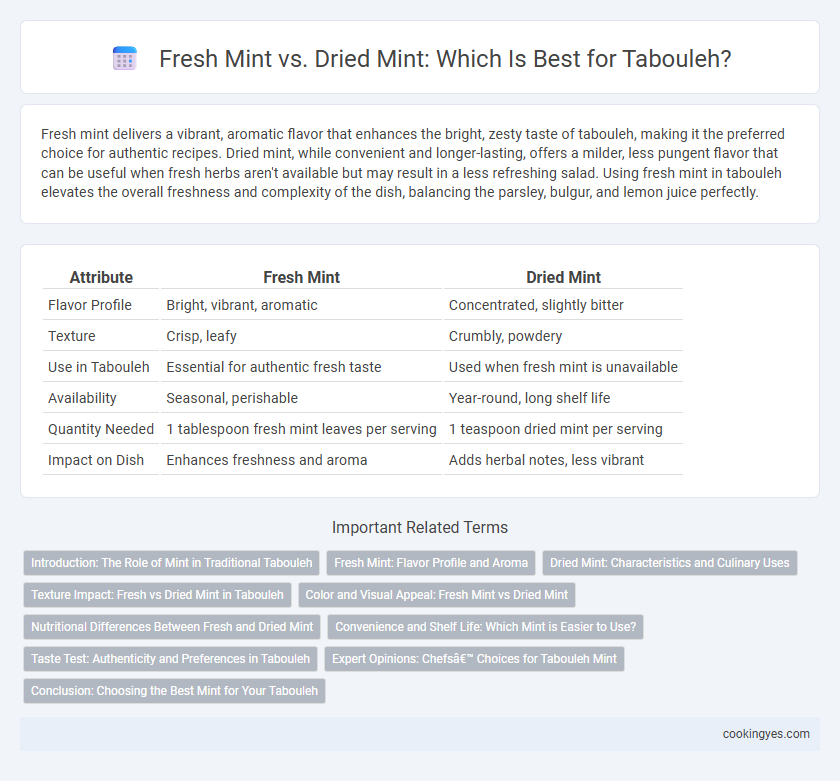Fresh mint delivers a vibrant, aromatic flavor that enhances the bright, zesty taste of tabouleh, making it the preferred choice for authentic recipes. Dried mint, while convenient and longer-lasting, offers a milder, less pungent flavor that can be useful when fresh herbs aren't available but may result in a less refreshing salad. Using fresh mint in tabouleh elevates the overall freshness and complexity of the dish, balancing the parsley, bulgur, and lemon juice perfectly.
Table of Comparison
| Attribute | Fresh Mint | Dried Mint |
|---|---|---|
| Flavor Profile | Bright, vibrant, aromatic | Concentrated, slightly bitter |
| Texture | Crisp, leafy | Crumbly, powdery |
| Use in Tabouleh | Essential for authentic fresh taste | Used when fresh mint is unavailable |
| Availability | Seasonal, perishable | Year-round, long shelf life |
| Quantity Needed | 1 tablespoon fresh mint leaves per serving | 1 teaspoon dried mint per serving |
| Impact on Dish | Enhances freshness and aroma | Adds herbal notes, less vibrant |
Introduction: The Role of Mint in Traditional Tabouleh
Fresh mint plays a crucial role in traditional tabouleh, offering vibrant, aromatic notes that dried mint cannot replicate. The herb's bright, grassy flavor enhances the dish's refreshing quality, balancing the tang of lemon and the earthiness of parsley. Using fresh mint ensures an authentic taste and texture, distinguishing classic tabouleh from variations that rely on dried herbs.
Fresh Mint: Flavor Profile and Aroma
Fresh mint in tabouleh delivers a vibrant, bright flavor with cooling notes that enhance the salad's refreshing quality. Its aromatic oils release a potent, crisp scent that complements the lemon and parsley, creating a balanced and invigorating herbaceous profile. Using fresh mint preserves the authentic Middle Eastern taste and intensifies the overall sensory experience of this classic dish.
Dried Mint: Characteristics and Culinary Uses
Dried mint offers a concentrated, earthy flavor that complements the fresh, zesty ingredients in Tabouleh without adding moisture, preserving the salad's crisp texture. Its longer shelf life and ease of storage make dried mint a practical choice for consistent seasoning, especially in regions where fresh mint is less accessible. Culinary use of dried mint in Tabouleh enhances the herbaceous notes while allowing precise control over flavor intensity, balancing parsley, bulgur, and lemon juice effectively.
Texture Impact: Fresh vs Dried Mint in Tabouleh
Fresh mint in tabouleh provides a vibrant, crisp texture that enhances the salad's refreshing mouthfeel, while dried mint offers a more subdued, powdery texture that can blend into the background. The fresh leaves contribute a slight crunch and juiciness, complementing the bulgur and chopped vegetables, whereas dried mint lacks this dimensionality, potentially making the texture less dynamic. Choosing fresh mint ensures a lively, textured eating experience that aligns with traditional tabouleh's characteristic freshness.
Color and Visual Appeal: Fresh Mint vs Dried Mint
Fresh mint imparts a vibrant green color that enhances the visual appeal of tabouleh, making the dish look more lively and appetizing. Dried mint tends to have a muted, darker tone that can dull the salad's overall appearance. Using fresh mint creates a more visually appealing presentation, highlighting the fresh ingredients typical of traditional tabouleh.
Nutritional Differences Between Fresh and Dried Mint
Fresh mint contains higher levels of vitamin C, antioxidants, and essential oils compared to dried mint, enhancing the nutritional profile of tabouleh with added immune support and anti-inflammatory benefits. Dried mint, while more concentrated, loses some volatile compounds and vitamin content during the drying process but provides a longer shelf life and intensified flavor. Incorporating fresh mint in tabouleh maximizes nutrient intake, whereas dried mint offers convenience without significantly compromising mineral content like calcium and iron.
Convenience and Shelf Life: Which Mint is Easier to Use?
Fresh mint offers vibrant flavor and aroma ideal for authentic tabouleh but requires refrigeration and has a short shelf life of about 5 to 7 days. Dried mint provides extended shelf stability, lasting up to 1 year when stored in an airtight container, making it more convenient for long-term use despite a milder taste. Choosing between fresh and dried mint depends on balancing the need for convenience and the desired intensity of mint flavor in tabouleh.
Taste Test: Authenticity and Preferences in Tabouleh
Fresh mint in tabouleh delivers a vibrant, aromatic flavor that closely aligns with traditional Levantine recipes, enhancing the salad's refreshing qualities. Dried mint, while convenient and longer-lasting, offers a more subdued, less nuanced taste that can slightly diminish the authenticity of the dish. Taste tests consistently show a preference for fresh mint due to its bright, crisp essence that elevates the overall balance of parsley, bulgur, and lemon in tabouleh.
Expert Opinions: Chefs’ Choices for Tabouleh Mint
Chefs widely favor fresh mint over dried mint for tabouleh due to its vibrant aroma and bright, refreshing flavor that enhances the dish's overall freshness. Expert culinary opinions highlight that fresh mint leaves provide a crisp texture and subtle sweetness, essential for balancing the tangy lemon juice and earthy bulgur. Although dried mint can be convenient, it lacks the complexity and lively notes that fresh mint contributes, making it less ideal for authentic tabouleh.
Conclusion: Choosing the Best Mint for Your Tabouleh
Fresh mint is the best choice for Tabouleh, offering vibrant aroma and bright flavor that dried mint cannot match. Using fresh mint enhances the dish's traditional freshness and balances the acidity of lemon juice. While dried mint is convenient, it lacks the vivid taste and texture that make Tabouleh truly authentic and refreshing.
Fresh Mint vs Dried Mint for Tabouleh Infographic

 cookingyes.com
cookingyes.com